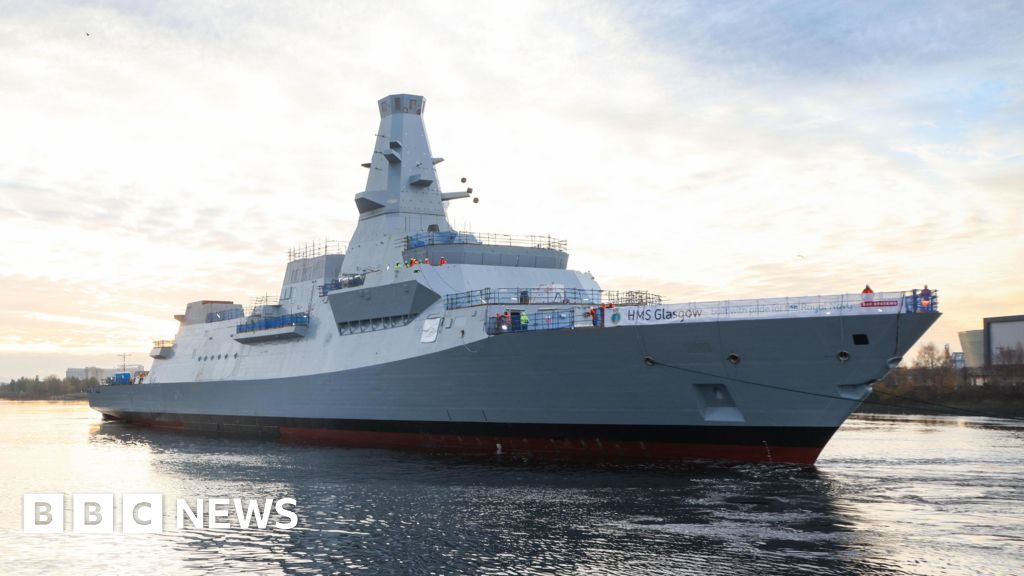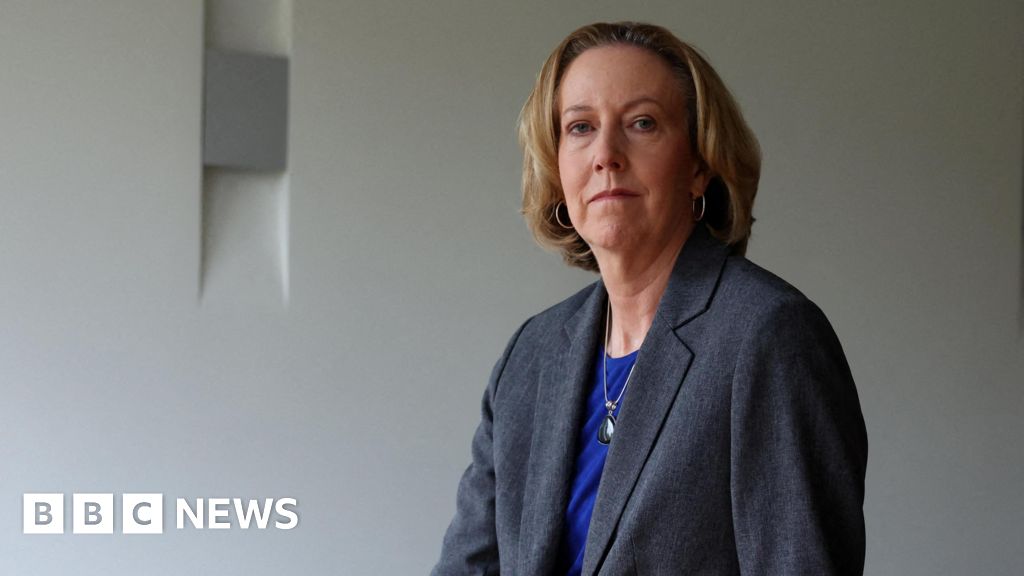Business
UK secures £10bn deal to supply Norway with warships

Jonathan BealeDefence correspondent and
Jessica RawnsleyBBC News
 UK MOD Crown Copyright
UK MOD Crown CopyrightThe UK has secured a £10bn deal to supply the Norwegian navy with at least five new warships.
The agreement to provide Type 26 frigates will be the UK’s “biggest ever warship export deal by value”, the Ministry of Defence (MoD) said, while Norway said it would be its largest “defence capability investment” to date.
The government said the deal would support 4,000 UK jobs “well into the 2030s”, including more than 2,000 at BAE Systems’ Glasgow shipyards where the frigates will be built.
UK Prime Minister Sir Keir Starmer said the agreement would “drive growth and protect national security for working people”.
“This success is testament to the thousands of people across the country who are not just delivering this next generation capabilities for our Armed Forces but also national security for the UK, our Norwegian partners and Nato for years to come,” he added.
The deal is also expected to support more than 400 British businesses, including 103 in Scotland, the MoD said.
Speaking to the BBC, defence minister Luke Pollard called it the “biggest British warship deal in history” and “a huge vote of confidence in British workers and the British defence industry”.
But the move was criticised by some in Norway, including Tor Ivar Strømmen, a naval captain at the Norwegian Naval Academy, who said French and German frigates were superior to British.
“The British Navy builds vessels for one role,” he told Norwegian outlet NRK. “It simply has old-fashioned and quite limited air defence.”
The agreement represents a victory for the British government and defence industry over France, Germany and the United States – which were also being considered by Norway as possible vendors.
It will create a combined UK-Norwegian fleet of 13 anti-submarine frigates – eight British and five Norwegian vessels – to operate jointly in northern Europe, significantly strengthening Nato’s northern flank.
The warships will be constructed at the BAE Systems yard in the Govan area of Glasgow, where frigates for the Royal Navy are currently being built.
Scottish Secretary Ian Murray said the choice of the UK “demonstrates the tremendous success of our shipbuilding industry and showcases the world-class skills and expertise of our workforce on the Clyde”.
Norway’s Prime Minister Jonas Gahr Støre, who informed Sir Keir of the decision to select the UK in a phone call on Saturday night, said the partnership “represents a historic strengthening of the defence cooperation between our two countries”.
Støre said the government had weighed two questions in its decision: “Who is our most strategic partner? And who has delivered the best frigates?… The answer to both is the United Kingdom.”
 PA Media
PA MediaThe Type 26 frigates purchased by the Royal Norwegian Navy will be as similar as possible to those used by their British counterparts, and have the same technical specifications.
They are specifically designed to detect, track, and destroy enemy submarines, with deliveries expected to begin in 2030.
UK Defence Secretary John Healey said the UK would “train, operate, deter, and – if necessary – fight together” under the defence deal.
“Our navies will work as one, leading the way in Nato, with this deal putting more world-class warships in the North Atlantic to hunt Russian submarines, protect our critical infrastructure, and keep both our nations secure,” he added.
Citing this year’s strategic defence review, Pollard said Russia had been identified “as the principal threat to not just the UK’s security but NATO’s security”.
“A key threat of that is Russian submarines in the North Atlantic,” he told the BBC. “These new Type 26 frigates are world-class submarine hunters.”
 PA Media
PA MediaEight Type 26 frigates are currently being built at BAE Systems’ Glasgow shipyards for the Royal Navy, to replace its ageing Type 23 frigates – whose service life has already had to be extended.
It is not yet clear how the Norway deal will impact the delivery of the new vessels to the Royal Navy.
A UK defence source said the plan was still to deliver all 8 Type 26 frigates to the Royal Navy within the next decade. Norway has said it wants its first Type 26 delivered by 2029.
British officials told the BBC that the sequencing of delivery for both Norway and the UK still had to be worked out.
Two of the warships, HMS Glasgow and HMS Cardiff, have been built and are currently being fitted out at a second BAE shipyard, Scotstoun. They are due to enter service in 2028.
Another three, HMS Belfast, HMS Birmingham and HMS Sheffield, are under construction.
BAE has also licensed the Type 26 design to Canada and is building the warships in Australia under contract.
As part of a £300m modernisation at BAE Systems, a new shipbuilding hall – dubbed the “frigate factory” – was opened earlier this year.
The Janet Harvey Hall, named after a pioneering female electrician, is large enough for two frigates to be built simultaneously.
The Royal Navy is also buying 5 new Type 31 General Purpose Frigates – which are being built at Rosyth.
Business
US economy grows at fastest pace in two years

The US economy picked up speed over the three months to September, as consumer spending jumped and exports increased.
The world’s largest economy expanded at an annual rate of 4.3%, up from 3.8% in the previous quarter. That was better than expected, and marked the strongest growth in two years.
The figures offer a clearer picture of the state of the US economy heading into the end of the year, after data collection had been delayed by the US government shutdown.
The report showed consumer spending rising by 3.5%, compared with 2.5% in the previous quarter.
Business
Fish and chip shop offers 100 free Christmas meals in Southampton

“It’s just a way of us giving back to the community,” says a fish and chip shop owner, who is giving away 100 free meals on Christmas Eve.
Raj Khaira, from Southampton, has owned Top Catch fish and chips in Shirley for five years and says he wants to support lonely people in the area.
He says he feels lucky to have a big family but knows for some customers a conversation with a shopkeeper might be the only one they have some days.
He says the shop will give portions of sausage and chips to those in need as a way of “giving back to the people who haven’t got family around them and sometimes can’t afford a hot meal”.
Mr Khaira speaks about working in business all of his life and how much he enjoys meeting “different people every day, from different backgrounds”.
“I’ve done it since I was a young kid so it’s all I really know,” he says.
He adds that many of his customers are elderly and do not have connections over the festive period.
“Christmas for majority of us is probably going to be a joyful and busy day but for some people it’s probably going to be a quiet day,” he says.
After posting about the plans to donate on social media he received a lot of publicity and Mr Khaira is prepared to “probably do more than” 100 meals.
He says the shop has already organised a toy and present drop off to Southampton hospitals this December, with many of the donations coming from customers.
He says: “We’re only where we are as a busy shop because of our community and our lovely customers that come in and sometimes you’ve got to give back and I’m happy to do that.”
Looking back on some of the negative news reported in Shirley earlier this year with the rise in anti-social behaviour in the area, he admits he had suffered.
His shop window was smashed in the summer, but he says: “Christmas time lets us just try and forget that for a minute and just try and have a good time, and reflect back on the year and hopefully next year is going to be a better one.”
Business
Gold price shines by Rs8,500 per tola – SUCH TV

The price of per tola 24-karat gold in Pakistan increased by Rs8,500 on Tuesday, reaching Rs470,862 compared to Rs462,362 on the previous day.
According to the All Pakistan Sarafa Gems and Jewellers Association, the price of 10 grams of 24-karat gold rose by Rs7,288, climbing to Rs403,688 from Rs396,400 on last day.
Likewise, the rate of 10 grams of 22-karat gold went up by Rs6,681, closing at Rs370,060 against Rs363,379.
In the international market, gold prices increased by $85, reaching $4,485 compared to $4,400 on the previous day.
Meanwhile, the price of per tola silver and that of 10-gram remained stagnant at Rs Rs7,205 and Rs6,177, respectively. International silver prices also remained unchanged at $69.30.
-

 Business1 week ago
Business1 week agoStudying Abroad Is Costly, But Not Impossible: Experts On Smarter Financial Planning
-

 Fashion5 days ago
Fashion5 days agoIndonesia’s thrift surge fuels waste and textile industry woes
-

 Business1 week ago
Business1 week agoKSE-100 index gains 876 points amid cut in policy rate | The Express Tribune
-

 Sports1 week ago
Sports1 week agoJets defensive lineman rips NFL officials after ejection vs Jaguars
-

 Business5 days ago
Business5 days agoBP names new boss as current CEO leaves after less than two years
-

 Entertainment1 week ago
Entertainment1 week agoPrince Harry, Meghan Markle’s 2025 Christmas card: A shift in strategy
-

 Tech5 days ago
Tech5 days agoT-Mobile Business Internet and Phone Deals
-

 Sports5 days ago
Sports5 days agoPKF summons meeting after Pakistani player represents India in kabaddi tournament






